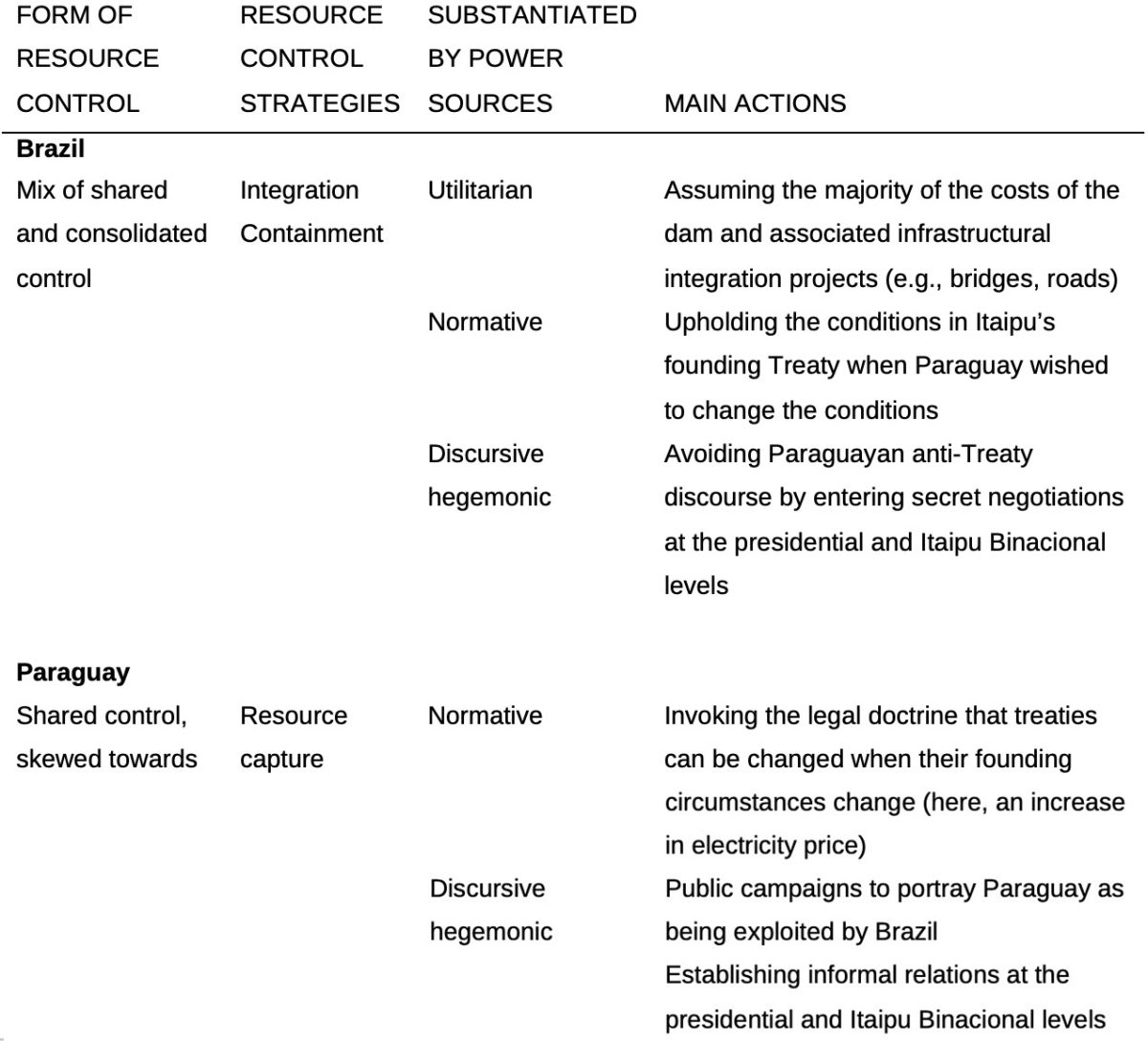The founding treaty of the third-largest hydroelectric dam in the world shared between regional hegemon Brazil and miniature but strategically located Paraguay, is up for renegotiation 50 years after its entry into force. The Itaipu Dam had a record production of 103,100 gigawatt-hours in 2016, comparable to the total electricity consumption of the Netherlands or the Philippines in 2021. Being of fundamental importance for these countries’ energy security, Itaipu covers around 10% of Brazilian and 90% of Paraguayan electricity consumption. Brazil and Paraguay are both entitled to fifty percent of the energy produced, but due to its small size, Paraguay is left with a vast surplus annually. The Itaipu Treaty’s financial section (‘Annex C’) states that Paraguay must sell that surplus to Brazil at below-market prices. Unhappy with these terms, Paraguay has repeatedly pushed for renegotiations over the past decades. At the start of construction in 1975, Brazil and Paraguay assumed debts of just over USD 3.5 billion (growing to USD 79 billion in 2023 due to overbilling and refinancing), including loans via Brazilian state utilities company Eletrobras. In October 2023, that debt was paid off, and 50 years after the treaty was entered into force, it was passed, which allowed the parties to renegotiate it.
However, these negotiations are pressured by disagreements over electricity pricing, climate change jeopardizing the dam’s output, and Paraguay’s economic development demanding a larger share of production. These disagreements escalated such that in April 2024, the Paraguay directors in Itaipu’s board refused to approve the yearly budget, deadlocking the dam’s administration. At the beginning of May of that year, the Brazilian mines and energy minister claimed to have reached a deal that would increase the price of energy sold by Paraguay to Brazil by 15.4% to USD 19.28 for the next three years, while Brazil will no longer pay Paraguay additional costs related to the plant from 2026. These renegotiations are fundamental to the dam’s administration, Brazil and Paraguay’s energy security, and the region’s transboundary water relations, but they cannot be grasped without a solid understanding of the history of these negotiations.
Therefore, this article analyzes the strategies and tactics employed by Brazil and Paraguay to control Itaipu’s resources between 2003-2023. To do so, this article adapts the discussion section of a paper in Regions and Cohesion by Berkhout and Warner (2023), which argues that Itaipu’s resource control can be best understood through the concept of Brazilian consensual hegemony (Burges, 2008), which will be discussed later in the article. The paper assesses the Itaipu Dam’s transboundary water relations for 2003-2023 by analyzing policy documents and thirteen interviews with experts, of which quotes are used in this article.
A brief history of negotiating Itaipu
The analysis starts in 2003, as momentum grew the year Lula da Silva assumed the presidency. Brazil began to privilege cooperation with South America, seeking more autonomy and diversity in Brazil’s foreign policy (Paula, 2013). This development coincided with the election of Fernando Lugo (2008-2012) in Paraguay, which ended the sixty-year rule of the conservative Colorado Party, partly due to the notion of ‘hydroelectric sovereignty,’ the campaign promise to attain more control over Paraguay’s resource, such as hydroelectricity from Itaipu (Folch, 2015). This led to an amended treaty in 2009. During Dilma Rousseff’s administration (2011-2016), Brazil’s focus on regional integration somewhat stalled, and relations with Paraguay became more distant after the impeachment of Lugo, classified by some as a coup d’état (Pereira Carneiro & Esposito Neto, 2022). Brazilian foreign policy shifted towards more traditional partners outside South America during Michel Temer’s presidency (2016-2018), a policy that was deepened under Jair Bolsonaro (2019-2022). The latter dealt with the expiration of Annex C of the Itaipu Treaty through secret negotiations with Paraguay’s president, Abdo Benítez (2018-present). In March 2021, it was decided to postpone the renegotiations until after the COVID-19 pandemic (Pereira Carneiro & Esposito Neto, 2022).
Resource control strategies
Resource capture occurs when “powerful groups in society (…) shift resource distribution in their favor” (Homer-Dixon, 1999, p. 177). A resource capture strategy is employed unilaterally, meaning that a state, moves ahead with projects that affect the flow or quality of the resource without formal agreements with other states (Waterbury, 1997, p. 279). A containment strategy involves active engagement with, or co-optation of, competitors to integrate or contain them in the most asymmetrical position possible. An integration strategy involves utilitarian power sources, such as benefits and privileges provided to other states through the hegemon’s relative power (Zeitoun and Warner 2006). These strategies are substantiated by power sources, as identified by Lustick (2002). Coercive power concerns the hegemon’s ability to mobilize capabilities to employ the use or threat of force. Secondly, utilitarian power holds that non-hegemons exchange compliance with the hegemon for something valuable. Thirdly, normative power is at play when the non-hegemon consciously believes compliance with the hegemon is in its best interest. Lastly, discursive hegemonic power, in line with neo-Gramscian theory, means that the hegemon can structure knowledge so that compliance with the hegemon becomes common sense (Strange, 1994, p. 176). These power sources substantiate strategies to obtain resource control in transboundary water relations.
Brazilian strategies
Brazil has used a mix of containment, integration, and, to a lesser extent, resource capture strategies to control Itaipu’s resources. Brazil’s ability to influence the Paraná River upstream by altering the river’s flow through new or existing dams on Brazilian territory is a structural power source that can be used as a potential means of pressure. As an interviewee said, “Whatever decision Brazil takes upstream, towards the Amazon region, affects the downstream flow in the River Plate Basin”.
Many examples of a Brazilian integration strategy, substantiated by utilitarian power sources, can be found from 2003-2022. A significant structural utilitarian power source comes from Brazil, which had paid for the dam initially, creating a large foreign debt for Paraguay to Brazil. This debt allowed Brazil to set favorable conditions, such as the obligation for Paraguay to sell all surplus energy – amounting to 95% – to Brazil at a below-market price. From 1985 to 2012, Brazil consumed, on average, 93% of Itaipu’s output. Brazil’s national electric utility company, Eletrobras, bought Paraguay’s share for approximately USD 10 per megawatt-hour, reselling it for between USD 20 and USD 60 on its domestic market (Folch, 2019; Paula, 2013). Our interviews reveal the integrative pressures as a result of mutual necessities that come with the construction of the dam and the establishment of Itaipu Binacional, the binational state-owned firm operating the dam: “In the case of Itaipu, [Brazil and Paraguay] used two national public utility companies and one public binational company. By doing that, one creates necessities. For example, if Itaipu ceases its activities, gigantic problems will surface for both Brazil and Paraguay”.
Utilitarian tactics of a more specific nature can be identified as well. During the government of Lula, utilitarian tactics were twofold. First, a priori, the Lula government did not consider any negotiation with Lugo but was willing to listen to Paraguay’s demands. For reasons described below, the two governments ultimately opened negotiations, leading to a three-fold increase in the value of Paraguay’s energy purchases, freedom of negotiation between Paraguay and other Brazilian companies, and the possibility for Paraguay to sell its surplus to third parties (Pereira Carneiro & Esposito Neto, 2022). These benefits can be perceived as a utilitarian tactic within Brazil’s regional foreign policy. Brazil, under Lula, engaged in a regional integration strategy through multilateral organizations UNASUR and Mercosur. Interviewees mentioned that Itaipu-connected projects received funding through these programs, through which Brazil used its utilitarian power to act as a regional hegemon, also in the hydroelectricity sector. For example, “Paraguay receives the most. Then comes Uruguay, and the ones that receive less are Argentina and Brazil. Contrarily, Brazil is the one that puts in the principal part”. Conversely, the construction of Itaipu was claimed to be an essential milestone in the regional integration process, for example, setting in motion the process leading to Mercosur (Pereira and Esposito 2022).
During Dilma Rousseff’s government (2011-2016), the integrative regional policy weakened, especially in the energy sector. An interview, for example, stated that “when Dilma Rousseff enters government, less emphasis is put on South American integration. Moreover, a large oil and gas reserve is discovered off the coast of Rio de Janeiro. (…) Here, regional energy integration in South America ends”. After Rousseff, Temer and Bolsonaro maintained outright isolationist foreign policies. In the case of Itaipu, however, continuity can be observed. Bolsonaro continued to grant Paraguay utilitarian benefits such as civil works in the context of Itaipu, paid by the Brazilian part of Itaipu Binacional. For example, from our interviews, it appeared that “Paraguayan Itaipu pays for the bridge in Chaco del Norte. Brazilian Itaipu funds the one in Presidente Franco (…), which is more expensive since Brazil has more resources”.
Brazil also maintained strategies to contain Paraguay, implemented by a mix of normative, utilitarian, and discursive hegemonic tactics. During Lula’s government, Brazil initially refused to renegotiate the Itaipu Treaty based on normative and utilitarian arguments. Normatively, Brazil’s foreign ministry referred to the Treaty of Itaipu. It claimed to have upheld the treaty in perfectly good faith, while Paraguay was damaging Brazil by trying to violate it. This aligns with Dellapenna’s (2003, p. 289) argument that hegemons may refer to international law to gain legitimacy for their claims and damage the non-hegemon’s reputation. It can be claimed that the Itaipu Treaty is a clear example of the institutionalization of existing inequalities described by Zeitoun and Warner (2006). This sentiment also emerges from the data: “I am not against high levels of institutionalization in the Southern Cone. I am against the inequity when applying the rules that come with supra-nationalism”. By using a utilitarian tactic (paying for the dam) in the short term, Brazil enabled itself to employ a normative tactic (upholding the Itaipu Treaty) in the long run, giving it a stick to contain Paraguay’s position when trying to modify the dam’s resource control in its favor.
A discursive hegemonic tactic to substantiate Brazil’s containment strategy can also be observed. In mid-2019, a scandal was revealed in which Abdo and Bolsonaro had reached a secret deal in which part of the Lugo-Lula deal was reversed, leading to less revenue for Paraguay and the obligation to sell electricity directly to Brazil. Abdo argued that Paraguay agreed upon these terms to create goodwill toward the treaty’s expiration in 2023 and subsequent negotiations. When the scandal almost led to the impeachment of Abdo, Bolsonaro agreed to cancel the deal and saved Abdo. This example demonstrates the Brazilian awareness of the treaty negotiations as a sanctioned discourse in Paraguayan society. As mentioned in an interview with a Paraguayan official: “Here, whenever we talk about these issues [of power asymmetries and Itaipu], we tend to mix cultural and historical reasons. So, often, it is an issue that generates a lot of political and social controversies”.
Paraguayan strategies
Paraguay profited from Brazil’s integration strategy by having a dam built primarily with Brazilian resources, which it had to pay back mainly by selling cheap surplus energy to Brazil. It aimed to change the conditions of those sales and the decision-making power within Itaipu Binacional through a resource capture strategy. However, Paraguay does not have the resources to substantiate that strategy with utilitarian power resources against Brazil. Hypothetically, it could offer Brazil material incentives through cheap electricity, but equaling this distribution is precisely the issue Paraguay aims to change. Therefore, Paraguay has mainly employed discursive hegemonic tactics and mixed normative-discursive hegemonic tactics. Under Lugo, Paraguay’s Foreign Ministry set up a Hydroelectric Commission, consisting of former leaders of student protests against then-Paraguayan dictator Alberto Stroessner. The Commission aimed to spread a narrative of a mistreated and exploited Paraguay, both in Paraguayan and Brazilian societies (Folch, 2019, pp. 123-124). This tactic was highly successful in Paraguayan society but proved futile in Brazil. Interviewed Brazilian officials even strongly maintained a counter-narrative that Paraguay had used Itaipu to distribute wealth among internal elites and not to develop its industry:
Today, Paraguay has a choice between renegotiating long-term export contracts with Brazil that guarantee revenue and using its energy to develop domestic industries. This sets in motion a series of internal interests we do not know about. Their choice is to renegotiate for a little cheaper energy instead of using its energy to develop and export to other countries.
Paraguay, however, aimed to influence Itaipu’s resource control through a second tack: the Paraguayan members of the board of Itaipu Binacional. The board comprises six Brazilian and six Paraguayan directors appointed by the two national electric utility companies, ANDE and Eletrobras. These directors were more technocratic than the ministry’s commission and engaged in informal relations with their Brazilian counterparts. They continuously expressed their determination to adhere to the Treaty while trying to invoke the legal doctrine that treaties can be changed if the conditions under which they have been signed have changed as well. In this case, it was argued that electricity prices had changed to the extent that one could speak of new circumstances (Folch, 2019, pp. 113). This constructed a narrative of changing the Itaipu Treaty within its normative framework, exemplified by the following quote from an interviewed Brazilian official:
In the past, Paraguay had a way smaller economy than Brazil. Today, some asymmetries between the strength of the two economies still exist. However, Paraguay has grown way more than Brazil. So, in 2023, it is another Paraguay in the discussion of the renovation of Annex C of the Treaty of Itaipu.
This change in hegemonic discourse was achieved by influencing informal relationships between technical teams instead of the general public. Here, the importance of personal relationships in South American international relations (e.g., Malamud, 2005) is underlined. Interviewees also pointed out the importance of relationships between bureaucratic teams, for example, within the Itaipu Binacional board and between national electricity companies: “The technical teams [of the national electricity companies] are there permanently. So, in my experience, on the macro level and the minister level, the truth is that they are not very successful in achieving integration. In Latin America, the most successful has always been to improve human relationships”.
From 2003 to 2022, it can be established that Brazil followed a strategy that combined integration and containment strategies to control Itaipu’s resources. These were implemented by utilitarian (paying for the dam), normative (the Itaipu Treaty), and discursive hegemonic (secret negotiations) tactics. Paraguay, in turn, aimed to capture more resources through normative and discursive hegemonic tactics by influencing the public, establishing informal relations at the presidential and dam administration levels, and changing the hegemonic treaty narrative.
Controlling Itaipu’s resources
The treaty of 1973 includes bottom-line guarantees on a fifty-fifty distribution of Itaipu’s electricity, and decision-making power within Itaipu Binacional is seemingly equally divided between six Paraguayan and six Brazilian directors. The interviewees often described the interaction between the two states as cooperative, for example: “Itaipu (…) is one of the major exponents of energy cooperation of the country”. In Itaipu’s day-to-day business, Itaipu Binacional runs the dam cooperatively and even initiates new cooperative projects, such as the Integration Bridge.
In this cooperative context, however, Brazil and Paraguay both attempt to consolidate control over the dam’s resources. Several indicators point towards Brazilian control. First, by the mix of normative tactics in the shape of the Itaipu Treaty and the utilitarian argument that it has paid for the dam, Brazil has secured a continuous flow of 93% of Itaipu’s enormous output from 1985 to 2019. This unequal distribution has been underlined time and again in the interviews. Through the Itaipu Treaty, Brazil has firmly consolidated this Paraguayan share because the Treaty makes it normatively impossible for Paraguay to sell its share to third countries. Second, decision-making power within Itaipu Binacional’s board seems equally distributed. However, some directors are ‘executive’ directors, enjoying more authority. The financial and engineering directors, which are the most essential, are always Brazilian, which gives Brazil more decision-making power (Folch, 2019, pp. 44-45). This adds to Brazilian control.
Paraguay, however, has not always willingly accepted Brazilian control in the period 2003-2022. Under Lugo, a proactive stance on hydroelectric sovereignty was assumed, and the status quo was contested. Through knowledge construction that changed the hegemonic discourse on the Itaipu Treaty, the treaty was renegotiated, and Paraguayan control slightly increased. For example, after renegotiating Lula and Lugo’s renegotiation of the Six Points, the meager price that Brazil paid for Paraguay’s Itaipu surplus was slightly increased, ANDE was allowed to set up a subsidiary in Brazil, and both parties expressed the intention to solve the Brazil-skewed decision-making power in Itaipu Binacional’s board. After Lugo, Paraguayan presidents Cortes and Abdo maintained a more non-disruptive stance towards Brazil and Itaipu. In 2019, towards the end of the period under scrutiny, the expiration of Annex C of the Itaipu Treaty in 2023 and subsequent negotiations already forced Abdo to negotiate despite his nondisruptive stance, which was done through secret negotiations. An actual contestation of Brazil’s resource control consolidation cannot be recognized here.
Paraguay lacks Lustick’s (2002) coercive, utilitarian, and normative dimensions of power to compete for Brazil’s consolidated resource control over Itaipu’s resources. The knowledge-constructing tactics it used to bend the hegemonic discourse on Itaipu in its favor did not suffice to compete with Brazil over its consolidated control. Considering Paraguay’s limited power resources and its careful approach towards Brazil, especially during the Cortes and Abdo administrations, Paraguay’s competition towards Brazil’s consolidated control can be described as cautious at most.
Discussion and conclusion: Consensual hegemony
It can be argued that the resource control situation of the Itaipu dam can be best described as a “consensual hegemony” by Brazil, a term borrowed from Burges (2008). Burges (2008) maintains that a hegemony gains its strength through “consent, not the latent threat of imposition” (p. 65), in so doing bringing it closer to a neo-Gramscian hegemony. A consensual hegemon seeks to subtly transcend its interests to non-hegemons by developing a regime that is also favorable to other regional actors. However, the promise – that under Brazil’s aegis, Latin America as a whole would gain a better position internationally – requires not only the consent of other Latin American nations but also of influential internal strata, making it a two-level game. States participating in the regime move towards a shared goal created by the hegemon.
The hegemony is the international regime to which all regional states adhere as they hope to benefit. The hegemon is the state that coordinates this structure and, by doing so, steers participating states towards its preferences. In the Brazilian context, Burges (2008) argues that Brazil is highly averse to being denominated a regional hegemon. The Brazilian Foreign Ministry realizes that Brazil cannot assume the economic and security costs of a hegemon, and it does not wish to deal with the adverse diplomatic effects, such as accusations of domination. Instead, the governments of presidents Cardoso (1995-2002) and Lula (2003-2010) maintained foreign policies that focused on common regional interests, such as democratic consolidation and the region’s insertion into the world economy (Burges, 2008). Examples are the creation of the Union of South American Nations (UNASUR) as an alternative to the US-led Organization of American States (OAS) (Mares & Trinkunas, 2016, p. 64), as well as the shift in Mercosur from a focus on international trade towards more socioeconomic and political issues (van Klaveren, 2018). This multilateral, regional regime established a true consensual hegemony during the Pink Tide. In that way, Brazil could steer and advance its interests within the regional security regime while the costs of creating multilateral institutions could be shared between the member states (Burges, 2008).
Instead, Brazil created a consensual hegemony coordinating a multilateral regime, including UNASUR and Mercosur. Brazil could steer the regime in its favor while costs were shared between the participating states. A similar dynamic can be observed in the case of the Itaipu Dam. Since Brazil does not want to be seen as a hegemon that exploits Paraguay, Lula, Dilma, and Bolsonaro all maintained discourses of friendship and cooperation. Instead of outrightly exploiting Paraguay, a shared international regime is kept in the shape of Itaipu Binacional. Within this regime, Brazil can steer Paraguay towards its preferences, such as a high supply of electricity at a low price, because it has slightly more decision-making power, and Paraguay is highly dependent on Brazil. As in a typical consensual hegemony, the costs of the international regime are shared since Brazil earns back its investment in the shape of cheap Paraguayan electricity.
Table 1. Overview of Brazilian and Paraguayan resource control strategies and employed power sources.

References
Berkhout, Pelle, and Jeroen Warner. 2023. “Transboundary Water Relations of the Itaipu Dam.” Regions and Cohesion 13 (3): 1–28. https://doi.org/10.3167/reco.2023.130302.
Burges, Sean W. 2008. “Consensual Hegemony: Theorizing Brazilian Foreign Policy after the Cold War.” International Relations 22 (1): 65–84. https://doi.org/10.1177/0047117807087243.
Dellapenna, J W. 2003. “Water Rights and International Law.” In The Iraqi Marshlands: A Human and Environmental Study, by P Clark and E Nicholson. Politico’s Publishing.
Folch, Christine. 2015. “The Cause of All Paraguayans? Defining and Defending Hydroelectric Sovereignty.” The Journal of Latin American and Caribbean Anthropology 20 (2): 242–63. https://doi.org/10.1111/jlca.12147.
———. 2019. Hydropolitics: The Itaipu Dam, Sovereignty, and the Engineering of Modern South America. Edited by Tom Boellstorff and Bill Maurer. Princeton University Press. https://doi.org/10.2307/j.ctvdf0j6c.
Homer-Dixon, Thomas F. 1999. Environment, Scarcity, and Violence. Princeton University Press. https://www.jstor.org/stable/j.ctt7pgg0.
Klaveren, Alberto van. 2018. “Regionalism in Latin America. Navigating in the Fog.,” February. http://www.wti.org/research/publications/1151/regionalism-in-latin-america-navigating-in-the-fog/.
Lustick, Ian. 2002. “Hegemony and the Riddle of Nationalism: The Dialectics of Nationalism and Religion in the Middle East.” Logos 1 (January):18–44.
Malamud, Andrés. 2005. “Presidential Diplomacy and the Institutional Underpinnings of MERCOSUR: An Empirical Examination.” Latin American Research Review 40 (1): 138–64. https://doi.org/10.1353/lar.2005.0004.
Mares, David R., and Harold A. Trinkunas. 2016. Aspirational Power: Brazil on the Long Road to Global Influence. Brookings Institution Press. https://www.jstor.org/stable/10.7864/j.ctt1dgn61j.
Paula, Orlando Fernandes de. 2013. “A política externa brasileira e as relações com o Paraguai: a revisão do Tratato de Itaipu.” Cadernos de Campo: Revista de Ciências Sociais, no. 17. https://periodicos.fclar.unesp.br/cadernos/article/view/7370.
Pereira, Camilo Carneiro, and Tomaz Neto Esposito. 2022. “Historical Relations between Brazil and Paraguay: Negotiations and Quarrels behind Itaipu Dam.” Conjuntura Austral 13 (62): 77–91. https://doi.org/10.22456/2178-8839.116432.
Strange, Susan. 1994. “Who Governs? Networks of Power in World Society,” June. https://doi.org/10.15057/8191.
Waterbury, John. 1997. “Between Unilateralism and Comprehensive Accords: Modest Steps toward Cooperation in International River Basins.” International Journal of Water Resources Development 13 (3): 279–90. https://doi.org/10.1080/07900629749692.
Zeitoun, Mark, and Jeroen Warner. 2006. “Hydro-Hegemony – A Framework for Analysis of Trans-Boundary Water Conflicts.” Water Policy 8 (5): 435–60. https://doi.org/10.2166/wp.2006.054.
This article is a slightly modified discussion section of Berkhout and Warner (2023), a paper published as the result of Pelle’s master thesis for the MA in International Relations at Leiden University.

 Movie
Movie 2 months ago
48
2 months ago
48 






![Presidents Day Weekend Car Sales [2021 Edition] Presidents Day Weekend Car Sales [2021 Edition]](https://www.findthebestcarprice.com/wp-content/uploads/Presidents-Day-Weekend-car-sales.jpg)



 English (United States)
English (United States)